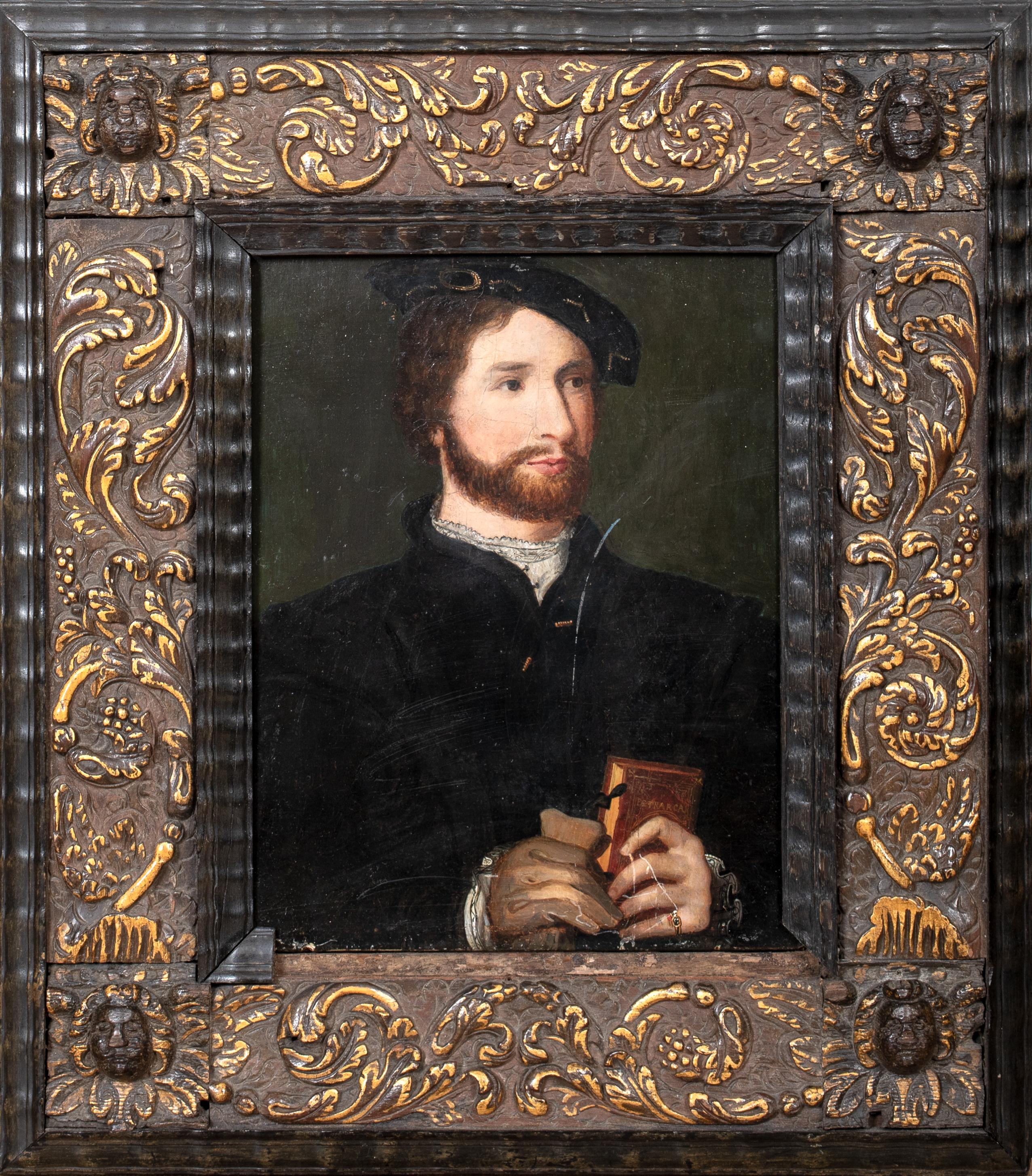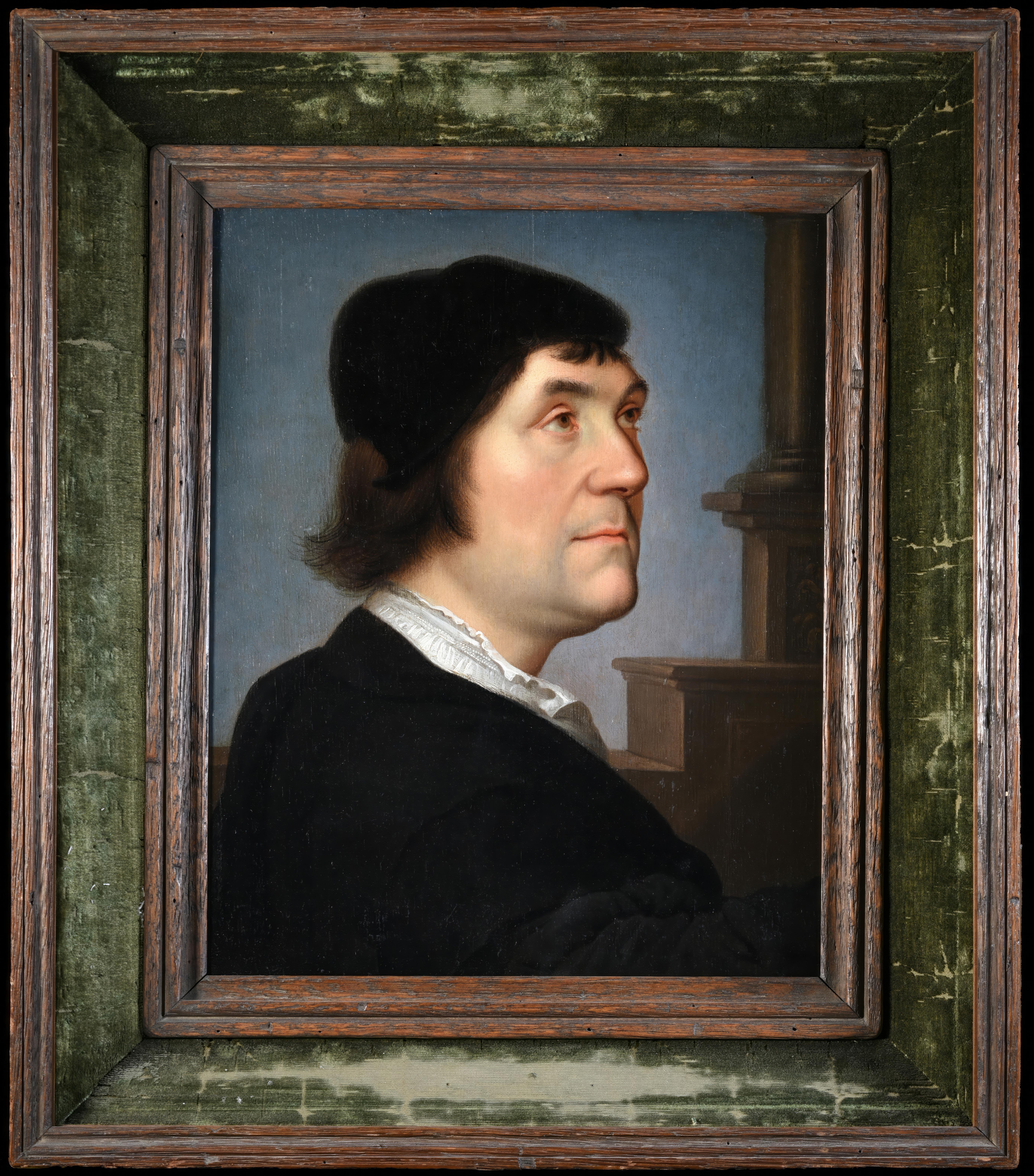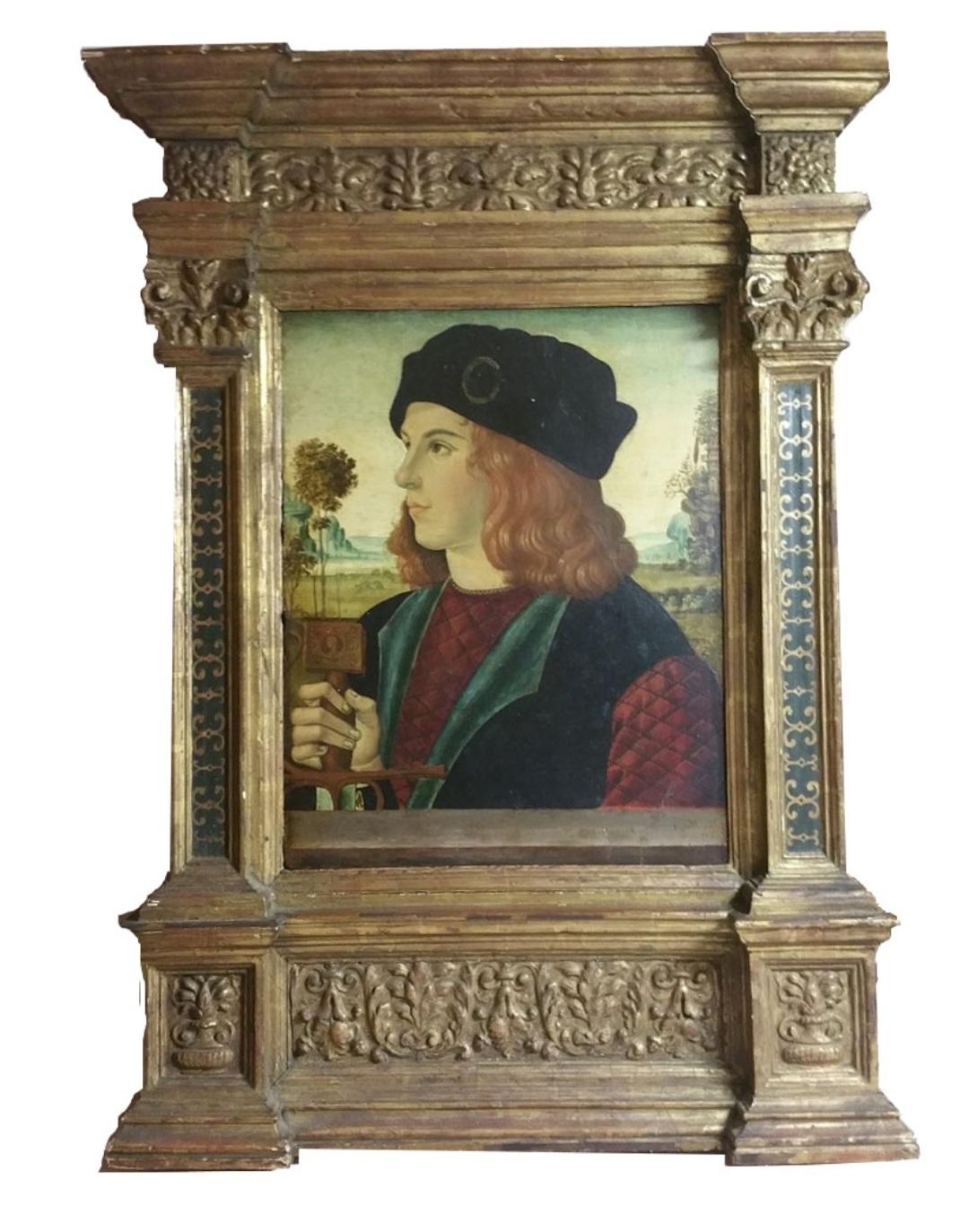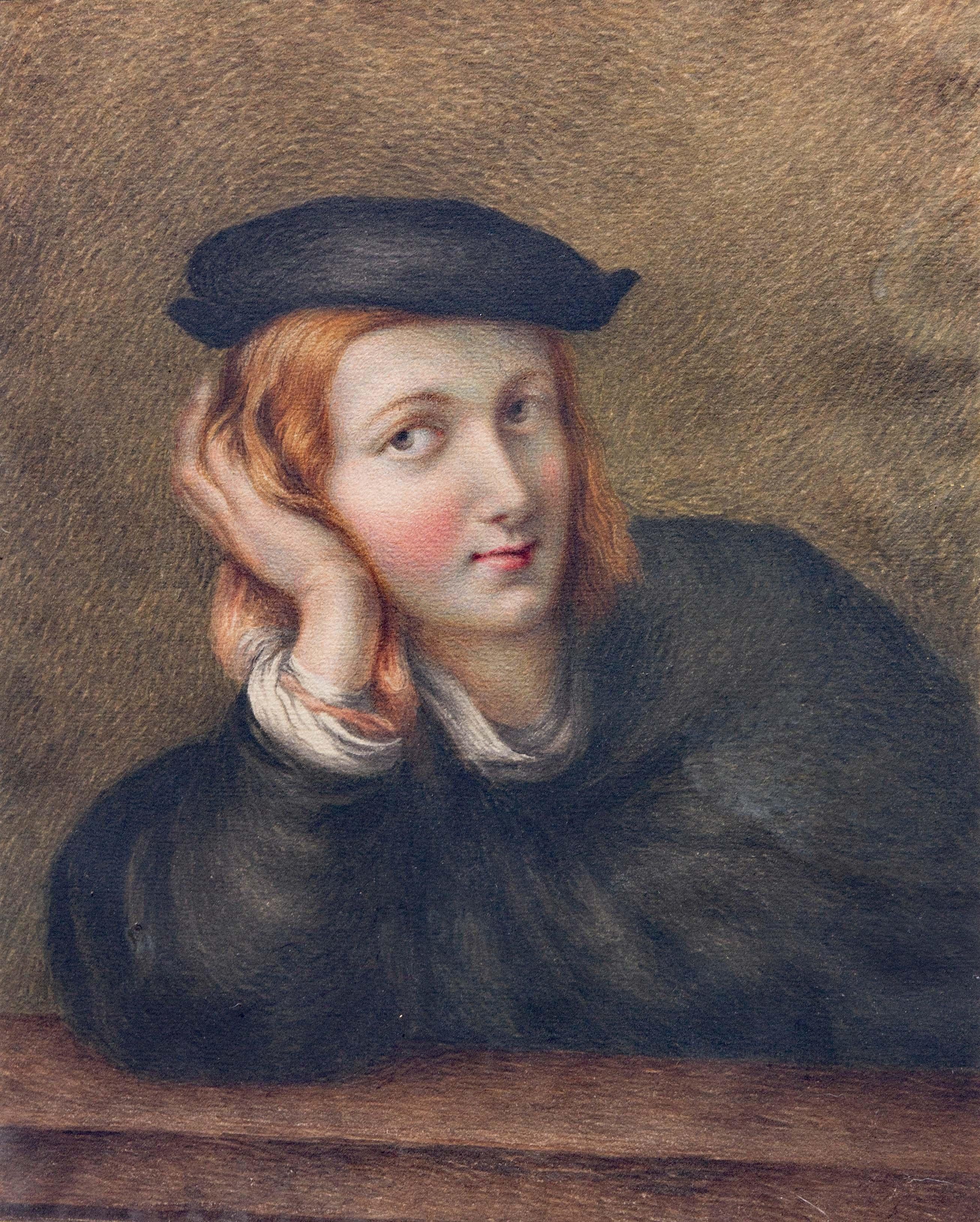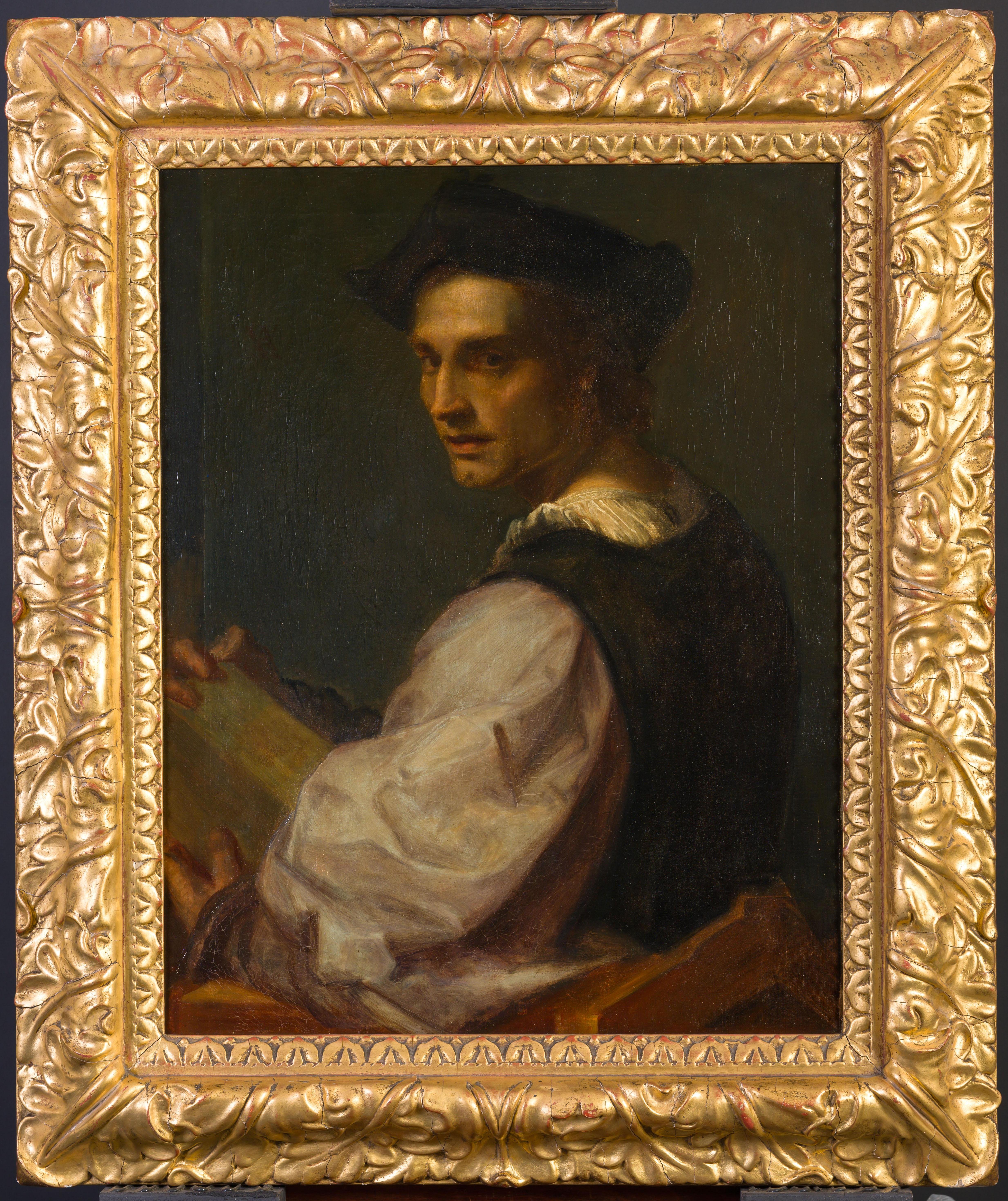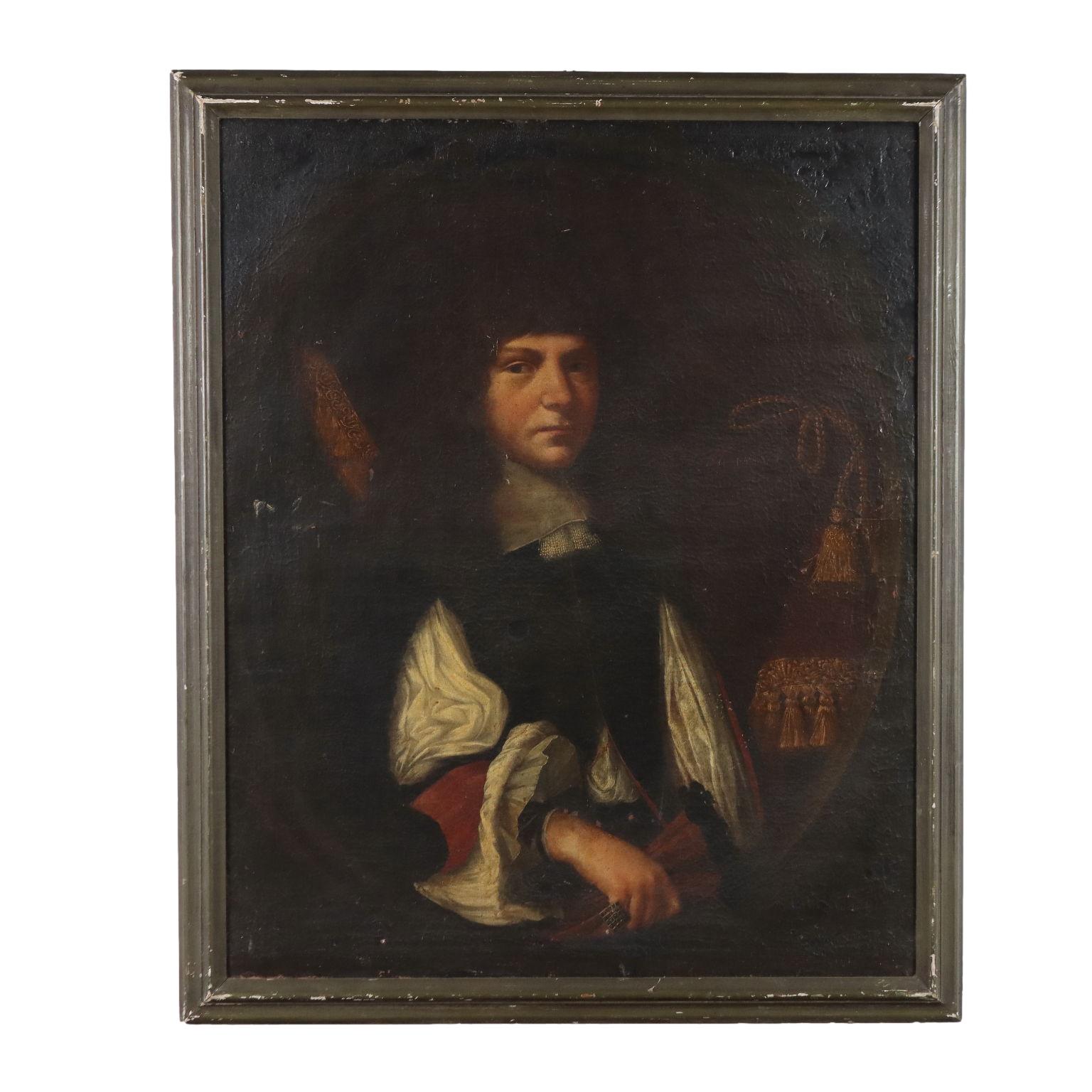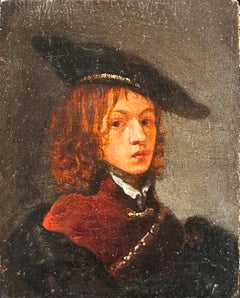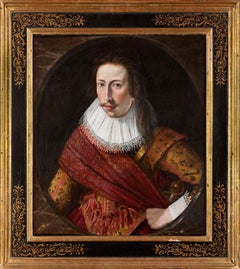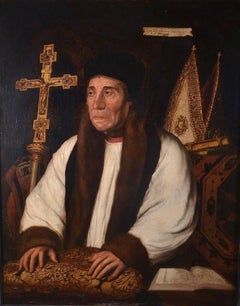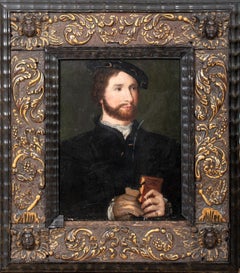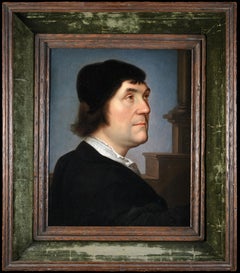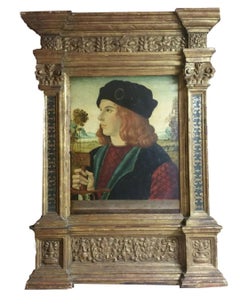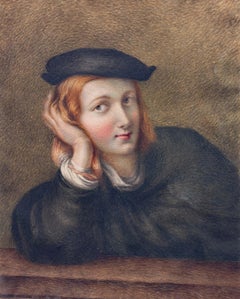Items Similar to Portrait of Derich Born (after Holbein)
Want more images or videos?
Request additional images or videos from the seller
1 of 3
Alfred Thomas DerbyPortrait of Derich Born (after Holbein)
$2,058.43
£1,500
€1,767.48
CA$2,857.21
A$3,205.25
CHF 1,657.21
MX$38,657.07
NOK 21,083.17
SEK 19,746.39
DKK 13,191.34
About the Item
Alfred Thomas Derby
Portrait of Derich Born (after Holbein)
1821-1873
Watercolour on paper, monogrammed lower right
Image size: 7 x 8 1/2 inches (18 x 23.8 cm)
UV non reflective glass & original gilt frame
This charming artwork is a watercolour copy of Hans Holbein the Younger’s 1533 of Derich Born. Born was a German merchant of considerable wealth, as demonstrated by the fashionable satin doublet coupled with the fur-lined cloak, who had his portrait painted by Holbein as part of the artist’s series of portraits of German merchants.
The Latin inscription at the bottom implies that the lifelike quality of the portrait prompts the viewer to question whether the artwork is a painting or a real person, a sentiment which takes on added meaning as this version is a watercolour copy from three centuries later. This watercolour retains the accuracy and lifelike qualities of Holbein’s original, especially with regard to Born’s face and clothing. The attention to detail from Derby in his copy indicates his competency as an artist with a keen eye for accuracy.
Alfred Thomas Derby
Alfred Thomas Derby was born in 1821 in London. His father was the watercolour and miniature painter William Derby, who undoubtedly passed his artistic capabilities to his son. Alfred studied at the Royal Academy and after finishing his studies, painted portraits and scenes from Walter Scott’s novels.
In 1838, William Derby suffered a stroke and his son Alfred began to assist his father in his work. William had been producing watercolour copies of the works of Landseer, amongst other artists. After William died, Alfred continued his father’s tradition of producing watercolour copies of the works of other artists, notably Gainsborough and Webster, with a distinct focus on figures and portraits. Derby exhibited over twenty works at the Royal Academy exhibitions between 1848 and 1872, as well as exhibiting at the Suffolk Street Gallery and the British Institution.
After suffering from an illness for two years, Derby died in 1873 and was buried in Highgate Cemetery. His works feature in private collections across the UK and abroad.
- Creator:Alfred Thomas Derby (1821 - 1873, English)
- Dimensions:Height: 9.38 in (23.8 cm)Width: 7.09 in (18 cm)
- Medium:
- Period:
- Condition:
- Gallery Location:London, GB
- Reference Number:1stDibs: LU52416563502
About the Seller
5.0
Vetted Professional Seller
Every seller passes strict standards for authenticity and reliability
Established in 2007
1stDibs seller since 2014
82 sales on 1stDibs
Typical response time: 2 hours
- ShippingRetrieving quote...Shipping from: London, United Kingdom
- Return Policy
Authenticity Guarantee
In the unlikely event there’s an issue with an item’s authenticity, contact us within 1 year for a full refund. DetailsMoney-Back Guarantee
If your item is not as described, is damaged in transit, or does not arrive, contact us within 7 days for a full refund. Details24-Hour Cancellation
You have a 24-hour grace period in which to reconsider your purchase, with no questions asked.Vetted Professional Sellers
Our world-class sellers must adhere to strict standards for service and quality, maintaining the integrity of our listings.Price-Match Guarantee
If you find that a seller listed the same item for a lower price elsewhere, we’ll match it.Trusted Global Delivery
Our best-in-class carrier network provides specialized shipping options worldwide, including custom delivery.More From This Seller
View AllPortrait of a Young Man
By (After) Rembrandt van Rijn
Located in London, GB
Pupil of Rembrandt
Portrait of a Young Man
17th Century
Oil on oak panel
Image size: 4 1/4 x 5 inches (11 x 13 cm)
Dutch ebonised frame
This small portrait is of a young man, staring inquisitively out towards the viewer. The realism of his appearance is striking, with great care taken in the depiction of the man’s features - for example, his full lips and the slight bump in the bridge of his nose. The man wears a rich burgundy doublet and a black cap and is adorned with gold accessories, indicating a degree of wealth - it is likely that this is a miniature portrait for a wealthy patron. The warm flesh tones of this painting and the intricate rendering of the man’s curly brown hair demonstrate the artistry of the painter, who has successfully captured the image of youth within his brushstrokes.
Rembrandt’s Pupils
Upon completing his artistic education, Rembrandt opened a studio and began to take students - the first of which were Gerrit Dou and Isaac Jouderville. The studio functioned as an art school, in which materials and guidance were provided - contrary to the studios of his peers, Rembrandt did not offer lodging to his pupils. The families of prospective pupils had to pay Rembrandt 100 guilders (enough for a house at the time) for this artistic education, and the profits from any works produced by pupils under Rembrandt would be paid to the master rather than kept by the student-artist - this contributed substantially to the master’s income.When taking on pupils, Rembrandt looked for those who could already paint, and guided their styles to reflect his. By choosing pupils who were somewhat experienced artists, Rembrandt had an array of painters that could be involved at any stage of assisting with the creation of his works - in this way, Rembrandt’s pupils often functioned as studio assistants as well. In order to perfect Rembrandt’s style, pupils would paint copies of their teacher’s works, sometimes adding their own distinct variations. They would use the same subjects and models as Rembrandt himself, and would accompany him on outdoor trips to paint nature and landscapes. The extensive copying and utilisation of same source materials has rendered Rembrandt’s work and the work of his pupils difficult to differentiate, even in the modern era.At least 50 pupils were taught by Rembrandt, with many continuing on to become his studio assistants. A few graduated into successful artists in their own right - for example, Govaert Flinck...
Category
17th Century Portrait Paintings
Materials
Oak, Oil, Panel
Portrait of William Herbert, 3rd Earl of Pembroke, Early 17th Century Portrait
Located in London, GB
English School, (circa 1600)
Portrait of William Herbert, 3rd Earl of Pembroke
Oil on panel, oval
Image size: 29¼ x 23⅞ inches
Painted wooden frame
Provenance:
176, Collection of Francis Greville, 1st Earl of Warwick.
The Trustees of the Lord Brooks’ Settlement, (removed from Warwick Castle).
Sotheby’s, London, 22nd March 1968, lot 81.
Painted onto wooden panel, this portrait shows a dark haired gentleman in profile sporting an open white shirt. On top of this garments is a richly detailed black cloak, decorated with gold thread and lined with a sumptuous crimson lining. With the red silk inside it’s all very expensive and would fall under sumptuary laws – so this is a nobleman of high degree.
It’s melancholic air conforms to the contemporary popularity of this very human condition, evident in fashionable poetry and music of the period. In comparison to our own modern prejudices, melancholy was associated with creativity in this period.
This portrait appeared in the earliest described list of pictures of Warwick castle dating to 1762. Compiled by collector and antiquary Sir William Musgrave ‘taken from the information of Lord & Lady Warwick’ (Add. MSS, 5726 fol. 3) is described;
‘8. Earl of Essex – an original by Zuccharo – seen in profile with black hair. Holding a black robe across his breast with his right hand.’
As tempting as it is to imagine that this is a portrait of Robert Devereux, the 2nd Earl Essex, we might take this with a pinch of salt. Its identification with this romantic and fatal Elizabethan might well have been an attempt to add romance to Warwick Castle’s walls. It doesn’t correspond all that well with Essex’s portraits around 1600 after his return from Cadiz. Notably, this picture was presumably hung not too far away from the castle’s two portraits of Queen Elizabeth I. The first, and undoubtedly the best, being the exquisite coronation portrait that was sold by Lord Brooke in the late 1970s and now hangs in the National Portrait Gallery. The second, described as being ‘a copy from the original at Ld Hydes’, has yet to resurface.
The portrait eventually ended up being hung in the State Bedroom of Warwick Castle.
Archival documents present one other interesting candidate. The Greville family’s earliest inventory of paintings, made in 1630 at their home Brooke House in Holborn, London, describes five portraits of identified figures. All five belonged to the courtier, politician and poet Sir Fulke Greville (1554-1628), 1st Baron Brooke, and were hung in the ‘Gallerie’ of Brooke House behind yellow curtains. One of them was described as being of ‘Lord of Pembrooke’, which is likely to have been William Herbert (1580-1630), 3rd Earl of Pembroke. William was the eldest son of Greville’s best friend’s sister Mary Sidney, and was brought up in the particularly literary and poetically orientated household which his mother had supported. Notably, the 3rd Earl was one of the figures that Shakespeare’s first folio was dedicated to in 1623.
The melancholic air to the portrait corresponds to William’s own pretensions as a learned and poetic figure. The richness of the robe in the painting, sporting golden thread and a spotted black fabric, is indicative of wealth beyond that of a simple poet or actor. The portrait’s dating to around the year 1600 might have coincided with William’s father death and his own rise to the Pembroke Earldom. This period of his life too was imbued with personal sadness, as an illicit affair with a Mary Fitton had resulted in a pregnancy and eventual banishment by Elizabeth I to Wilton after a short spell in Fleet Prison. His illegitimate son died shortly after being born. Despite being a close follower of the Earl of Essex, William had side-stepped supporting Devereux in the fatal uprising against the Queen and eventually regained favour at the court of the next monarch James I.
His linen shirt is edged with a delicate border of lace and his black cloak is lined on the inside with sumptuous scarlet and richly decorated on the outside with gold braid and a pattern of embroidered black spots.
Despite the richness of his clothes, William Herbert has been presented in a dishevelled state of semi-undress, his shirt unlaced far down his chest with the ties lying limply over his hand, indicating that he is in a state of distracted detachment. It has been suggested that the fashion for melancholy was rooted in an increase in self-consciousness and introspective reflection during the late 16th and early 17th centuries.
In contemporary literature melancholy was said to be caused by a plenitude of the melancholy humor, one of the four vital humors, which were thought to regulate the functions of the body. An abundance of the melancholia humor was associated with a heightened creativity and intellectual ability and hence melancholy was linked to the notion of genius, as reflected in the work of the Oxford scholar Robert Burton, who in his work ‘The Anatomy of Melancholy’, described the Malcontent as ‘of all others [the]… most witty, [who] causeth many times divine ravishment, and a kind of enthusiamus… which stirreth them up to be excellent Philosophers, Poets and Prophets.’ (R. Burton, The Anatomy of Melancholy, London, 1621 in R. Strong, ‘Elizabethan Malady: Melancholy in Elizabethan and Jacobean Portraits’, Apollo, LXXIX, 1964).
Melancholy was viewed as a highly fashionable affliction under Elizabeth I, and her successor James I, and a dejected demeanour was adopted by wealthy young men, often presenting themselves as scholars or despondent lovers, as reflected in the portraiture and literature from this period. Although the sitter in this portrait is, as yet, unidentified, it seems probable that he was a nobleman with literary or artistic ambitions, following in the same vain as such famous figures as the aristocratic poet and dramatist, Edward de Vere...
Category
Early 17th Century Old Masters Portrait Paintings
Materials
Oil, Wood Panel
Portrait of an Officer, Cornelius Johnson, 17th Century Old Masters
By Cornelius Johnson
Located in London, GB
Circle of Cornelius Johnson
Circa 1620’s
Portrait of a Officer
Oil on canvas
Image size: 28 x 24 inches
Period style hand made frame
Provenance
Private European Estate
This striking portrait dates to around 1620, as you can see from the images of the sash the detail is very high. The sash is decorated with gold thread and would have cost a small fortune at the time. Sashes were originally developed for a military function (making officers more visible for their men during combat), but soon became a primarily male fashion...
Category
Early 17th Century Old Masters Portrait Paintings
Materials
Oil
PORTRAIT OF WILLIAM WARHAM, Old Masters Oil on Wood
Located in London, GB
after HANS HOLBEIN THE YOUNGER
1497 – 1543
PORTRAIT OF WILLIAM WARHAM
Oil on canvas
Image size: 38 x 35 inches (89 x 71 cm)
Hand made period style frame
The handling of the paint in...
Category
18th Century and Earlier Old Masters Portrait Paintings
Materials
Canvas, Oil
Portrait of Nicholas Poyntz
Located in London, GB
Remigius Van Leemput
Portrait of Nicholas Poyntz
1607-1675
Oil on oak panel
Image size: 13 x 10 1/4 inches (33 x 26 cm)
Contemporary style frame
Provenance
The Dalva Brothers Colle...
Category
17th Century Flemish School Portrait Paintings
Materials
Oil, Panel
Portrait of Ralph William Grey
By Bartholomew Dandridge
Located in London, GB
Provenance
By descent through the sitter's family to
The Collection of R. W. Vivian-Neal of Poundisford Park, Somerset, from whom acquired by
With Lane Fine Art, UK, where purchased by the present owners in 1996
Literature
'Poundisford Park, Somerset' in Country Life, 22 December 1934, ill.
A.W. and C.M. Vivian-Neal, Poundisford Park, Somerset: A catalogue of pictures and furniture, Taunton 1939, cat. nos. 11 and 13
This is a three-quarter-length portrait of Ralph William Grey in a mole-coloured velvet coat and a long waistcoat of green satin, heavily embroidered in gold. Under his left right hand is a black chapeau bras. He has white doe-skin gauntlet gloves.
Son of William and Ann Grey of Backworth: born 19 December 1707. He married Mary the daughter of William Rawstorne of Newall in 1741 and died 5 November 1786. He was educated at Eaton and Trinity College, Oxford.
Within a year of his birth Mrs Grey died and, according to the Country Life article 'From that time forward all Mr Grey's faculties were concentrated on the well-being of his son. The possession of an heir gave zest to his efforts to build up the family fortune: he was successful in most of his ventures. Years later his interest in life was centred in the home of his daughter-in-law and grandchildren'.
Grey's right hand is depicted in the present portrait resting on Locke's Essays and the Country Life article also records that there are constant references to John Locke...
Category
Mid-18th Century English School Portrait Paintings
Materials
Oil
You May Also Like
Portrait Of Henry Howard, Earl of Surrey (1516-1547), 16th Century
Located in Blackwater, GB
Portrait Of Henry Howard, Earl of Surrey (1516-1547), 16th Century
English School Court Portrait
16th century English Court Portrait of Henry Howard, Earl of Surrey, oil on panel. ...
Category
16th Century Portrait Paintings
Materials
Oil, Wood Panel
A portrait of John Poyntz, after Hans Holbein, ca. 1644 - 1674
By Hans Holbein
Located in New York, NY
A portrait of courtier and politician John Poyntz, after Hans Holbein, circa 1644 - 1674. This painting is based on a drawing by Hans Holbein, part of the drawings collection of the ...
Category
Mid-17th Century Renaissance Portrait Paintings
Materials
Oil, Wood Panel
$24,000 Sale Price
52% Off
Portrait of a Young Boy
Located in Saratoga Springs, NY
Attributed Federico Icilio Joni (1866-1946, North Italian Sienese)
“Portrait of a Young Boy”
17 ¾ x 14” (on poplar panel)
Icilio Federico J...
Category
19th Century Old Masters Figurative Paintings
Materials
Panel, Oil
$20,000
Portrait Painting of Raphael Early 19th Century Italian
Located in Rochester, NY
Portrait painting of old master artist Raphael. Early 19th century Italian watercolor. Unsigned. Contemporary frame.
Category
19th Century Figurative Paintings
Materials
Watercolor
Portrait of a Sculptor
By Andrea Del Sarto
Located in Douglas, Isle of Man
After Andrea Del Sarto 1486 - 1530, who was an Italian Renaissance painter and draughtsman. Del Sarto worked in Fresco decorating, portrait painting and as a painter of alter pieces,...
Category
Mid-19th Century Portrait Paintings
Materials
Canvas, Oil
Painting Male Portrait 17th century
Located in Milan, IT
Oil on Canvas. 17th century Dutch school.
The young nobleman, very serious, looks out from an oval painted frame, on which he rests his hand to flaunt the family ring.
The painting...
Category
17th Century Other Art Style Portrait Paintings
Materials
Oil
More Ways To Browse
Antique Viewer
Antique Portrait Miniature
German Portraits 19th Century
Dior Miniatures
19th Century German Painting Portrait
Philippe De Champaigne
Puritan Oil Painting
Robert Eric Moore
Robert Menzies
Roni Stretch
Zhang Bo
1860 Oil Painting Of Woman In Black Dress
Barkley Hendricks
Battle Of Boyne
Bernardino Campi
Damilola Ilori
Ecstasy Of Saint Teresa
Elisabeth Dujarric De La Riviere
